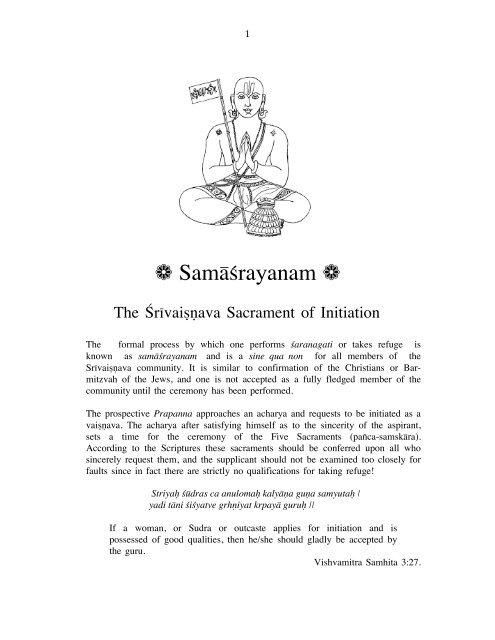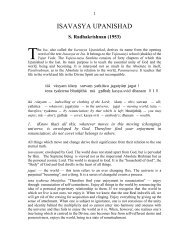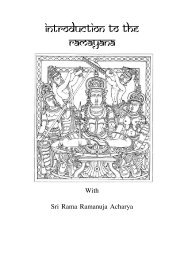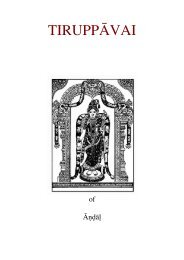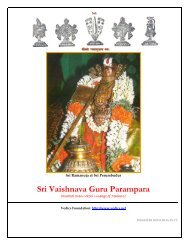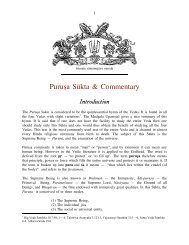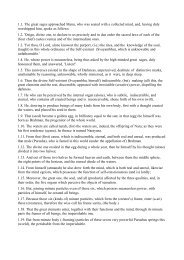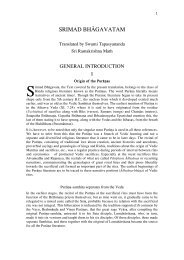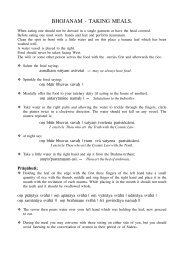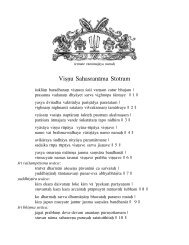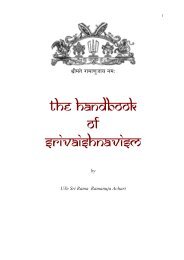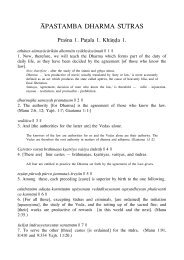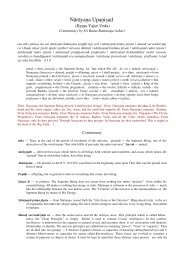Sri-Vaishnava Initiation - Yajur Veda Australasia - Resources
Sri-Vaishnava Initiation - Yajur Veda Australasia - Resources
Sri-Vaishnava Initiation - Yajur Veda Australasia - Resources
You also want an ePaper? Increase the reach of your titles
YUMPU automatically turns print PDFs into web optimized ePapers that Google loves.
1<br />
❁ Samåçrayanam ❁<br />
The Çrîvaiß±ava Sacrament of <strong>Initiation</strong><br />
The formal process by which one performs çaranagati or takes refuge is<br />
known as samåçrayanam and is a sine qua non for all members of the<br />
Srîvaiß±ava community. It is similar to confirmation of the Christians or Barmitzvah<br />
of the Jews, and one is not accepted as a fully fledged member of the<br />
community until the ceremony has been performed.<br />
The prospective Prapanna approaches an acharya and requests to be initiated as a<br />
vaiß±ava. The acharya after satisfying himself as to the sincerity of the aspirant,<br />
sets a time for the ceremony of the Five Sacraments (pañca-samskåra).<br />
According to the Scriptures these sacraments should be conferred upon all who<br />
sincerely request them, and the supplicant should not be examined too closely for<br />
faults since in fact there are strictly no qualifications for taking refuge!<br />
Striya¿ çûdras ca anuloma¿ kalyå±a gu±a samyuta¿ |<br />
yadi tåni çiçyatve grh±iyat krpayå guru¿ ||<br />
If a woman, or Sudra or outcaste applies for initiation and is<br />
possessed of good qualities, then he/she should gladly be accepted by<br />
the guru.<br />
Vishvamitra Samhita 3:27.
2<br />
Program of <strong>Initiation</strong><br />
1. Udaka Çånti - Sanctification & Empowerment<br />
In this ceremony jars of water are placed upon an altar and various cosmic forces<br />
are invoked for their blessings. The rite is preceded by the invocation and<br />
worship of Viçvaksena for the removal of all obstacles to the achievement of<br />
success in ones spiritual endeavours. Various passages from the <strong>Veda</strong>s are<br />
chanted by the priests invoking the cosmic forces. The presiding deity of the<br />
mind (Indra) is invoked to protect the spiritual aspirant on the arduous spiritual<br />
path and to give him/her the power to combat the enemies of spiritual<br />
advancement - selfish desire, anger, delusion, greed, envy, pride etc. The cosmic<br />
witness (Varuna) is invoked to watch the progress of the aspirant and to goad<br />
him/her on to success. Agni (the presiding deity of fire) is invoked to purify the<br />
aspirant from all previous sins and to offer protection and guidance. The forces<br />
of wisdom are invoked to bestow learning and the ability to understand the<br />
teachings. Thus the spiritual aspirants are absolved of all their previous sins and<br />
offences and empowered to accept the teachings and to practice them.<br />
Once the water has been sanctified through these Vedic chants the aspirants are<br />
bathed and don new garments indicative of their re-birth.<br />
2. Pu±yåha Våcanam<br />
Another brief sanctification ceremony is done in order to purify all the<br />
accessories of the ritual and the other participants. Prayers are offered for the<br />
removal of all negative mental states which hinder the dawning of wisdom.<br />
3. Rakßa Bandhanam<br />
A rite of protection is done and a blessed thread is tied around the wrist of each<br />
participant in order to protect them from all negativity that may be directed at<br />
them during the actual initiation ceremony by opposing forces.
3<br />
4. Pra∞åna Homa<br />
The fire representing wisdom is kindled and sanctified and then offerings are<br />
made by the officiating priests reciting various Vedic hymns to Vishnu — the<br />
Supreme Person. All oblations are made with the exclamation S∆åhå which means<br />
— I am offering myself as an oblation for the welfare of all sentient beings. The<br />
purpose of this Pañcaråtric initiation ceremony is to qualify and empower one for<br />
the worship of the Supreme Being and for serving all the creation which is His<br />
external manifestation. All sentient beings are moving temples of the divine and<br />
the spiritual aspirant will practice mindfulness of this principle and act<br />
accordingly to enhance the joy of all other sentient beings - even sacrificing ones<br />
own happiness for that of others.<br />
After the conclusion of the fire ceremony the first sacrament is conferred.<br />
5. Tåpa<br />
The sacrament of branding the aspirant with the symbols of the conch and discus<br />
is done as penance for past sins and as a sign of ones complete self-dedication to<br />
the spiritual path. This in turn brings about a reformation of the self and the<br />
bearing of the marks of the conch and discus upon the shoulders remind one that<br />
he/she is an eternal servant of the Lord. The discus Sudarsana reminds the<br />
devotees that they are not subjected to the laws of time and fortune, and that they<br />
should be free from the fear of being crushed by the false charges that are<br />
brought against them by their enemies.<br />
The following prayer is recited by the postulant prior to accepting the Discus<br />
Brand:<br />
O refulgent Sudarshana, as bright as an hundred thousand suns,<br />
lead me from the darkness of ignorance and guide me on the Path<br />
of the Supreme Godhead.<br />
Before receiving the brand of the conch the supplication is recited:<br />
O holy conch Panchajanya, your sound vibration (AUM)<br />
destroys the heap of sins that have been accumulated by me<br />
through my previous births. Save me who am drowning in the<br />
ocean of Samsara from the attentions of the wicked.<br />
The second of the five sacraments is now performed.
4<br />
6. Pu±¥ram<br />
The second sacrament guarantees protection against temptation. The body is<br />
considered to be the temple of the Lord and so through the application of the<br />
sacred markings one sacralises one's physical being. The forehead is the seat of<br />
Kesava, which means that He is thought of as protecting the mind from negative<br />
thoughts. The belly is the seat of Narayana the breast that of Mådhava, the throat<br />
is that of Govinda or 'the giver of delight'; the right side is the seat of Viß±u, the<br />
'all-pervading-lord'; the right arm is the seat of Madhusûdana, and the right<br />
shoulder that of Trivikrama, the Mighty Lord who with His three strides<br />
measured the universe; the left side is that of Våmana; the left arm is that of<br />
Çrîdhara, and the left shoulder that of H®ßikeça, the Lord and guide of the senses<br />
and the mind. The back is the seat of Padmanåbha - the original fountainhead of<br />
creative power. The neck is the seat of Lord Damodara, the all independent<br />
Lord, who is always dependant upon His devotees. And finally the head is<br />
thought to be the seat of Våsudeva or the-one-who-dwells-everywhere.<br />
Many Sacred texts enjoin this custom and further stress that no religious work<br />
yields merit if the performer is devoid of the sacred marks.<br />
The pundram that is worn on the forehead and body has three lines-- two vertical<br />
white ones with a red line in the middle. These lines represent the Holy Feet of<br />
the Lord, with the goddess of mercy between them. The projecting line running<br />
down the nose, represents the First Principle — Parabrahman, the rootless root.<br />
7. Dåsya nåma<br />
The third sacrament is that of the Nåmakara±a or name-giving. It is the noble<br />
ambition of the penitent soul to earn a name worthy of a true servant of the Lord<br />
- "a dåsya nåma". In Tamil the word Tiru is added before the word nama to<br />
signify, that the person who has received such a name has become the object of<br />
Divine favour in as much as he or she has been favoured by the spiritual master<br />
by giving a name other than the one by which one is ordinarily known by all<br />
and sundry. Such a name preserves the moral integrity, and acts as a powerful<br />
protection against temptation by reminding one constantly, that the servitude of<br />
God and the devotees, is the very essence of one's being and the goal of one's<br />
existence.
5<br />
8. Mantra upadeça<br />
The fourth sacrament is the bestowal of the sacred mantras — the three jewels.<br />
Mantra is so called because it protects the mind and redeems one from Samsåra<br />
or cycle of birth and death. The Postulants are now instructed in the recitation<br />
and meaning of these three sacred texts.<br />
9. Yåga<br />
The fifth sacrament is that of complete self-surrender to the Supreme Person and<br />
the acceptance of the governance of ones life by the sacred canons of the<br />
Pañcaråtra. This means following a sacred routine of life as laid down in the<br />
canons of the Tantric texts, known as 'aradhana-viddhi', or the method-ofdivine-servitude.<br />
A sacred routine of life means, a routine that is calculated to<br />
sanctify one's life. Life consists of a series of actions which may be mental,<br />
verbal or physical, and these actions can become sacred when a routine is<br />
followed which transforms one's thoughts, actions and aspirations. The routine<br />
must be planned in such a way as to leave no room for indulgence in anything<br />
unworthy and undesirable. The prapanna undertakes the division of the daily<br />
programme into five parts; abhigamana, upadåna, ijya, svadhyåya & yoga.<br />
Abhigamana - briefly means the daily visit to the temple of the<br />
Lord in order to worship the iconic manifestation. In the present<br />
circumstances because this is physically not possible it refers to the<br />
recollection and contemplation upon the four main Vaiß±ava<br />
Shrines — <strong>Sri</strong>rangam, Tirupati, Kanchi and Melkote.<br />
The second part is the upadåna, which consists of collecting all<br />
the articles of worship such as flowers, fruit darbha grass, tulsi<br />
leaves etc. All the articles offered to God must have been acquired<br />
by honest and fair means.<br />
The third part is called îjya which includes such activities as the<br />
daily worship of the Lord in ones home, and the performance of<br />
the pañca-maha-yajñas or the five-great-sacrifices enjoined in the<br />
Scriptures. Every person is under obligation throughout his/her life<br />
to repay five debts ; to the deities by making offerings, to the<br />
manes by performing sraddha rites, to the rishis by religious<br />
studies, and to society by feeding guests and strangers, and finally<br />
to the birds and the beasts by food offerings.
6<br />
Before beginning to eat, the food should first be offered to the<br />
Lord in the form of offerings to the five vital breaths (pranahuti).<br />
Having partaken of food, one should then in the evening engage in<br />
s∆ådhyåya — the study of the Sacred texts such as the hymns of<br />
the Alvars, Itihasas, Puranas and other sacred literature, and<br />
expound the mysteries of the sacred mantras to others who are<br />
willing to listen.<br />
Then before retiring to bed one should perform yoga — meditation<br />
upon the divine form of the Lord with all His excellent attributes,<br />
the remembrance of which removes all mental impurities. The<br />
mind which is difficult to restrain, is brought under control by<br />
steady mindfulness, contemplation, controlling of the senses and<br />
speech. And then finally one should retire to bed with the thought<br />
that one is safe at the feet of the Lord.<br />
In this manner not a moment of the day is wasted in idle pursuits. Such an ideal<br />
sacred routine of life can be followed only be the grace of the Supreme and Allmerciful<br />
Lord. Indeed fortunate are those that can lead such a life, they are truly<br />
the favourites of the Lord, and are worthy to be followed by others.<br />
Thus in brief is given the description of the five purificatory rites which sanctify<br />
and empower one to follow the path of the Pañcaråtra, to achieve perfection and<br />
to practice a life-style through which life's mission is fulfilled.<br />
R


